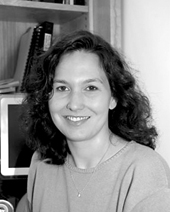Our Science – Reilly Website
Karlyne M. Reilly, Ph.D.
 |
|
|||||||||||||||||||||||||
Biography
Dr. Reilly received her Ph.D. in molecular and cellular biology from Harvard University in 1997, under Dr. Douglas Melton. She trained as a postdoctoral fellow in the laboratory of Dr. Tyler Jacks at the Center for Cancer Research of MIT, where she held fellowships from the Leukemia & Lymphoma Society, the AACR-Sidney Kimmel Foundation, and the American Cancer Society. In 2002, she established the Genetic Modifiers of Tumorigenesis Group at the Center for Cancer Research, NCI. Her laboratory focuses on mouse models of cancer to study the biology of tumorigenesis and the genetic basis of variable susceptibility to cancer.
Research
Astrocytoma is one of the most common forms of brain cancer, accounting for close to 40% of all primary brain tumors. Due to its diffusely infiltrative nature, malignant astrocytoma is essentially incurable, because complete surgical resection is not possible and current therapies cannot be localized to the tumor cells without damaging normal brain tissue. Better understanding of astrocytoma initiation, progression, and infiltration is necessary to design more effective therapies for the treatment of this disease. Patients with the genetic diseases neurofibromatosis type 1 and Li-Fraumeni syndrome are at an increased risk for developing astrocytoma, and this demonstrates that the neurofibromin (NF1) and p53 tumor suppressor pathways are important in preventing astrocytoma. We have developed a mouse model of malignant astrocytoma by combining mutations in Nf1 and p53. This model recapitulates the stages of progression and diffuse infiltration seen in astrocytoma patients. We are using this model to gain insight into the biology of astrocytoma specifically and to better understand the genetic influences on susceptibility to cancer.
Cancer arises through a series of mutations that give a cell a growth advantage over surrounding cells, through inappropriate cell survival and cell proliferation. An individual's genetic background can affect tumorigenesis through a variety of mechanisms, such as the processing of mutagens by the body, the rate at which mutations can be repaired, the effectiveness of redundant cell cycle checkpoints within the cell, or the interaction of the surrounding tissue with the growing tumor. In this way, different alleles of modifier genes can determine whether or not the individual develops cancer. For example, neurofibromatosis type 1(NF1) is one of the most common human genetic diseases affecting the nervous system and is characterized by clinical heterogeneity, whereby one family member may have a severe form of the disease while another may have a mild form. Studies on families of patients have shown that modifier genes affect the number of benign tumors that form. Furthermore, our data on a mouse model of NF1 demonstrates that modifier genes similarly affect the malignant tumors associated with NF1. While genetic experiments demonstrate the effects of modifier genes on cancer, the identity of these genes and their mode of action are unknown.
Our laboratory is focused on using mouse models to identify modifier genes affecting resistance to astrocytomas as well as other tumors associated with NF1. Different strains of mice are more or less susceptible to developing different tumor types, so by choosing particular strain combinations we can map the location of modifier genes in the genome. The recent sequencing of the mouse and human genomes will provide us with a list of candidate modifier genes within the mapped region. Our laboratory is also using a combination of in vitro and in vivo approaches to study astrocytoma biology, with the goal of applying what we learn in the mouse to developing novel therapeutics for patients. Because this mouse model recapitulates the diffuse infiltration and stages of progression seen in human tumors, we are focusing on these aspects of astrocytoma biology. We are taking advantage of cell lines derived from these mice to study the cell biology and biochemistry of these tumors in culture, and testing our hypotheses through genetic crosses of mutant mice and characterization of primary tumors.
The end goal of this research is to improve current treatments for human cancer, and astrocytoma in particular, through a better understanding of tumor biology. In addition to identifying new molecular targets for rational drug design, we are developing this model for testing new therapies. We are taking advantage of new initiatives in small animal imaging to develop in vivo imaging and identify early tumors for treatment studies. In addition, engineering more precise ways of initiating these tumors will make the timing of drug studies much easier. We are using conditional floxed alleles of Nf1 and p53 and the Cre recombinase to remove the wild-type copies of Nf1 and p53 and control the timing of tumor initiation.
Our collaborators include: Hideho Okada, University of Pittsburgh; Eric Holland, Memorial Sloan Kettering, New York; Karl Broman, John Hopkins University, Baltimore; and Nancy Ratner, University of Cincinnati.
This page was last updated on 6/12/2008.

